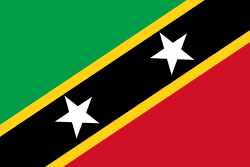Robert Llewellyn Bradshaw
| Robert Llewellyn Bradshaw | |
|---|---|
 | |
| First Premier of Saint Kitts and Nevis | |
|
In office 27 February 1967 – 23 May 1978 | |
| Succeeded by | Paul Southwell |
| Chief Minister of Saint Kitts and Nevis | |
|
In office July 1966 – 26 February 1967 | |
| Preceded by | Paul Southwell |
| Personal details | |
| Born |
16 September 1916 Saint Paul Capisterre, Saint Kitts |
| Died |
23 May 1978 (aged 61) Basseterre, Saint Kitts |
| Political party | Labour Party (1946–1978)[1] |
Robert Llewellyn Bradshaw (16 September 1916 – 23 May 1978) was the first Premier of Saint Kitts and Nevis in the Caribbean, and previously served as Chief Minister, legislator, and labour activist. Bradshaw is credited with leading Saint Kitts and Nevis to independence.
Early life
Bradshaw was born in the Saint Paul Capisterre Village in Saint Kitts to Mary Jane Francis, a domestic servant, and William Bradshaw, a blacksmith. He was raised by his grandmother after his father moved to the United States when Bradshaw was nine months old.[1] He attended St. Paul's Primary School and completed seventh grade, the highest level of primary education available in Saint Kitts at the time.[2]
At 16, Bradshaw became a machine apprentice at the St. Kitts Sugar Factory, where he began to take interest in the labour movement. In 1940, he left the sugar factory following a strike for higher wages and joined the St. Kitts and Nevis Trades and Labour Union as a clerk. Bradshaw succeeded Joseph Matthew Sebastian as president of the union in 1944.[1]
In 1963 he married, Millicent Sahaley, a Kittitian-Lebanese. They had one daughter, Isis Carla Bradshaw, together. He also had a second daughter, Etsu, from an earlier relationship.
Political career
Bradshaw supported the cause of the sugar workers, and was one of the political stalwarts of the country. He entered politics in 1946 and won a seat in the Legislative Council in the elections that year, later becoming a member of the Executive Council. In 1956 he was Minister of Trade and Production for St. Kitts-Nevis-Anguilla. During the short-lived West Indies Federation (from 1958 to 1962), Bradshaw was elected to the Federal House of Representatives and held the post of minister of finance for the Federation.
After the break-up of the Federation, Bradshaw returned to St. Kitts from Trinidad. In 1966 he became Chief Minister, and in 1967 the first Premier of St. Kitts-Nevis-Anguilla, now an associated state of the United Kingdom. Under his leadership, all sugar lands as well as the central sugar factory were bought by the government. Opposition to Bradshaw's rule began to build, especially by the families of former estate owners, who founded the People's Action Movement party in 1964, after frustration over a failed demonstration against a raise in electricity rates. Opposition was especially great in Nevis, where it was felt that the island was being neglected and unfairly deprived of revenue, investment and services by its larger neighbour. Bradshaw mainly ignored Nevis' complaints, but Nevisian disenchantment with the Labour Party proved a key factor in the party's eventual fall from power.
In 1977 Bradshaw travelled to London for independence talks with the United Kingdom government.
Death
Bradshaw died on 23 May 1978 of prostate cancer at his home in Basseterre.[3] He was succeeded by his former deputy, Paul Southwell.He is buried in Springfield cemetery in Basseterre.
Legacy
In 1996, Bradshaw was posthumously awarded the title of First National Hero by the National Assembly of Saint Kitts and Nevis and is honoured annually on National Heroes Day, which is observed on his birthday.[4] On the inaugural National Heroes Day in 1998, the Golden Rock Airport in Saint Kitts was renamed the Robert L. Bradshaw International Airport in his honour.[5] In 2007, the Robert Llewellyn Bradshaw Memorial Park was dedicated at his birthplace in St. Paul's.[6] On 17 September 2010, the Robert Llewellyn Bradshaw building was dedicated on the Windsor University School of Medicine campus in Cayon.[7]
References
- 1 2 3 "Robert Llewellyn Bradshaw - St. Kitts 1st National Hero". SKNVibes. Retrieved 24 September 2011.
- ↑ "Who Was Robert Bradshaw?". The Virgin Islands Daily News. 26 May 1978. Retrieved 24 September 2011.
- ↑ Harewood, Gerry (10 June 1978). "A Caribbean statesman passes | Robert L. Bradshaw". The Afro American. Retrieved 24 September 2011.
- ↑ "This website is currently unavailable.". cuopm.com.
- ↑ "SKNVibes - “National Heroes in Photos” available online". sknvibes.com.
- ↑ "SKNVibes - Inauguration of Robert Bradshaw Memorial Park set for September 16th". sknvibes.com.
- ↑ Williams, Erasmus (18 September 2010). "Medical University names new classroom building in honour of Sir Robert Llewellyn Bradshaw". SKNVibes. Retrieved 25 September 2011.
Further reading
- Alexander, R. J. and Eldon Parker (2004). A History of Organized Labor in the English-Speaking West Indies. Westport, CT: Praeger.
- Brown, Margaret and W. R. Louis (2001). The Oxford History of the British Empire. Oxford: Oxford University Press.
- Burks, Edward (1967). "New Caribbean State Beset by Poverty and Revolt." New York Times. June 29.
- Hurwitz, Samuel (1966). "The Federation of the West Indies: A Study in Nationalism." Journal of British Studies 6.
- Knight, F. W. and Colin Palmer (1986). The Modern Caribbean. Chapel Hill, NC: University of North Carolina Press.
- (1978). "Robert Bradshaw Dies: Premier in Caribbean." The Washington Post. May 25.
- Thorndike, Tony (1989). "The Future of the British Caribbean Dependencies." Journal of Interamerican Affairs and World Studies 31.
| Titles and Succession | ||||||
|---|---|---|---|---|---|---|
|
| ||||||||
|
